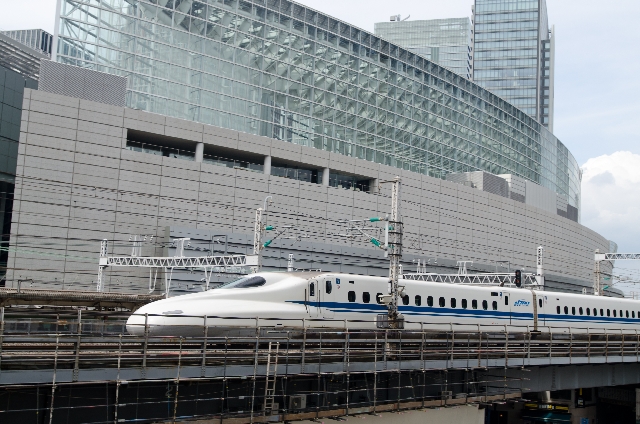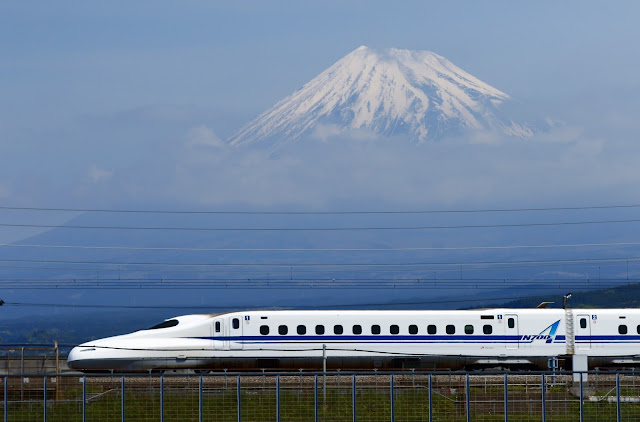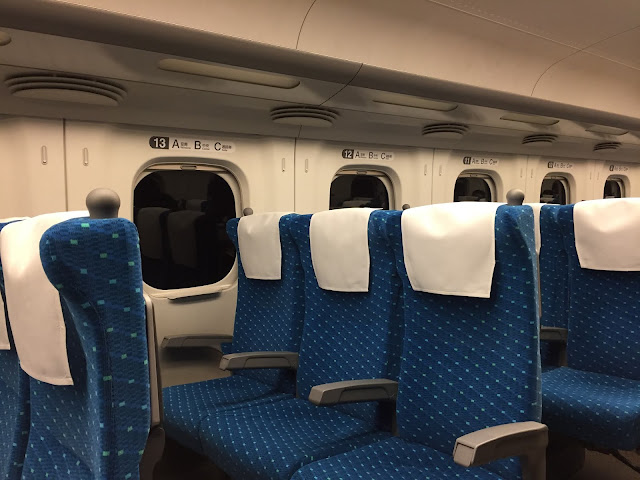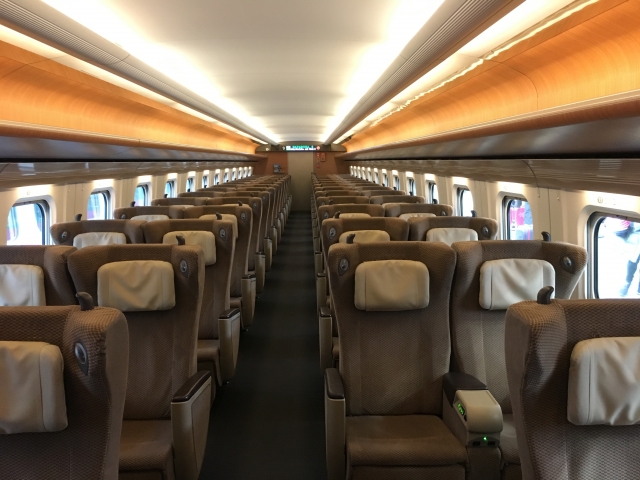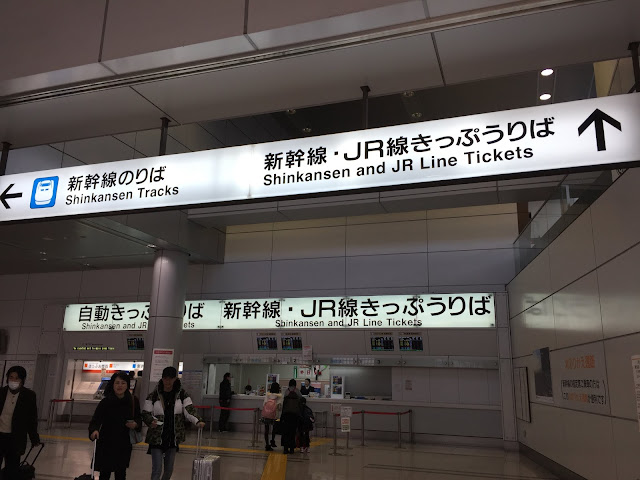Shinkansen information - understand what Shinkansen is
Shinkansen information
Contents of Shinkansen (bullet train) information
Overview
The shinkansen (新幹線、しんかんせん), also known as the bullet train, is a high-speed train operated by Japan Railways Group (JR Group) in Japan. It is the most popular transportation for medium to long distance travel, several hundred kilometers to one thousand kilometers, by businesspersons and tourists. The total length of shinkansen lines is over 3000 km.
History
- The shinkansen started its operation in 1964. Initially, it was operated between Tokyo Station and Shin-Osaka Station, 515 kilometers, as Tokaido Shinkansen. Its speed was 210 km/h at that time.
- 8 years later, in 1972, the shinkansen was expanded to Okayama Station as Sanyo Shinkansen. Sanyo Shinkansen was expanded to Hakata Station in Kyushu island in 1975.
- In 1982, Tohoku Shinkansen started its operation between Omiya Station in Saitama prefecture and Morioka Station in Iwate prefecture. And in the same year, Joetsu Shinkansen also started its operation between Omiya Station and Niigata Station. And, in 1985, the line between Omiya Station and Ueno Station in Tokyo was opened, resulting in Tohoku and Joetsu Shinkansen available in Tokyo. In 1991, the line was connected to Tokyo Station.
- In 1990s, Yamagata Shinkansen, Akita Shinkansen, and Hokuriku Shinkansen were started operation. Yamagata Shinkansen and Akita Shinkansen share the tracks with local train services and the speed is 130km/h, about half speed of other shinkansen lines. Therefore, these lines are called mini-shinkansen.
- In 2002, Tohoku Shinkansen was expanded to Hachinohe Station in Aomori prefecture and then to Shin-Aomori Station in 2010.
- In 2004, Kyushu Shinkansen started its operation in Kyushu island between Shin-Yatsushiro Station in Kumamoto prefecture and Kagoshima-Chuo Station in Kagoshima prefecture. And, in 2011, Kyushu Shinkansen was expanded and connected to Hakata Station in Fukuoka prefecture.
- In 2016, Hokkaido Shinkansen started its operation between Shin-Aomori Station and Shin-Hakodate-Hokuto Station in Hokkaido. By this expansion, the Shinkansen connects 3 islands of Japan, Hokkaido, Honshu, and Kyushu.
Speed
When Tokaido Shinkansen started its operation, its maximum speed was 210 km/h. By technological progresses, the current maximum speed of Tokaido Shinkansen is 285 km/h. Now, the maximum speed of all shinkansen lines is 320 km/h by Tohoku Shinkansen.
Here are the maximum speed for each line:
- Tokaido Shinkansen 210 km/h
- Sanyo Shinkansen 300 km/h
- Tohoku Shinkansen 320 km/h
- Joetsu Shinkansen 240 km/h
- Yamagata Shinkansen 130 km/h (mini-shinkansen)
- Akita Shinkansen 130 km/h (mini-shinkansen)
- Hokuriku Shinkansen 260 km/h
- Kyushu Shinkansen 260 km/h
- Hokkaido Shinkansen 260 km/h
Lines
There are 7 shinkansen lines with 2764.6 km and 2 mini-shinkansen lines with 275.9 km.
Shinkansen lines:
Tokaido Shinkansen
- Operated by JR Central
- 515.4 km
- From Tokyo Station to Shin-Osaka Station
Sanyo Shinkansen
- Operated by JR West
- 553.7 km
- From Shin-Osaka Station to Hakata Station
Tohoku Shinkansen
- Operated by JR East
- 674.9 km
- From Tokyo Station to Shin-Aomori Station
Joetsu Shinkansen
- Operated by JR East
- 269.5 km
- From Omiya Station to Niigata Station
Hokuriku Shinkansen
- Operated by JR East and JR West
- 345.4 km
- From Takasaki Station to Kanazawa Station
Kyushu Shinkansen
- Operated by JR Kyushu
- 256.8 km
- From Hakata Station to Kagoshima-chuo Station
Hokkaido Shinkansen
- Operated by JR Hokkaido
- 148.8 km
- From Shin-Aomori Station to Shin-Hakodate-Hokuto Station
Mini-shinkansen lines:
Yamagata Shinkansen
- Operated by JR East
- 148.6 km
- From Fukushima Station to Shinjo Station
Akita Shinkansen
- Operated by JR East
- 127.3 km
- From Morioka Station to Akita Station
Types of train service
There are several train services depending on number of stops.
Tokaiddo Shinkansen & Sanyo Shinkansen
- Nozomi: the fastest train service stopped at only major stations
- Hikari: semi-fast train service stopped at major stations and some popular stations
- Kodama: tarin service stopped at all stations
Sanyo Shinkansen & Kyushu Shinkansen
- Mizuho: the fastest train service stopped at only major stations
- Sakura: semi-fast train services stopped at major stations and some popular stations
- Tsubame: rain service stopped at all stations (mainly in Kyushu shinkansen line)
Tohoku Shinkansen & Hokkaido Shinkansen
- Hayabusa: the fastest train service stopped at only major stations
- Hayate: semi-fast trains stopped at major stations and some popular stations
- Yamabiko: semi-fast train service stopped major stations and some popular stations, operates between Tokyo Station and Morioka Station
- Nasuno: train service stopped at almost all stations, operates between Tokyo Station and Koriyama Station
Joetsu Shinkansen
- Toki/Max Toki: semi-fast train service stopped at popular stations
- Tanigawa/Max Tanigawa: train services stopped at all stations, operates between Tokyo Station and Gala-Yuzawa Station (stopped in winter only)
Hokuriku Shinkansen
- Kagayaki: the fastest train stopped at only major stations
- Hakutaka: semi-fast train stopped at major stations and some popular stations
- Asama: train service stopped at almost all stations, operates between Tokyo Station and Nagano Station
- Tsurugi: train service operated between Toyama Station and Kanazawa Station
Yamagata Shinkansen
- Tsubasa: all trains regardless of number of stops
Akita Shinkansen
- Komachi: all trains regardless of number of stops
Car and seat types
There are 2 or 3 car types depending on lines and trains, ordinary car, Green car, and GranClass car. Ordinary car has 2 seat types, reserved seat, and non-reserved seat. Green car and GranClass have reserved seats only.
Ordinary car
An ordinary car is the third-class car with lowest prices. And the ordinary car usually has 2 seat types, reserved seat and non-reserved seat. However, there are some trains without any non-reserved seats.
A reserved seat requires a reserved seat ticket with information of travel, train, and seat. A reserved seat ticket shows departure station, arrival station, departure time, arrival time, train service name, train No., car No., and seat No. Passenger can have a seat at the printed train and the seat only.
A non-reserved seat ticket does not show any train No, car No., and seat No. It shows a departure station and an arrival station. Also, it shows the date of availability, often 1 day or 2 days.
Ordinary cars have 5 seats in row, separated 3 and 2.
Green car
A Green cart is the second-class or the first-class car. For Tohoku Shinkansen, Hokkaido Shinkansen, Joetsu Shinkansen, and Hokuriku Shinkansen, the Green car is the second-class car since there is an upper-class car, GranClass car. For other lines, the Green car is the first-class car with the highest price.
All seats at Green cars require Green car tickets. A Green cart ticket shows departure station, arrival station, departure time, arrival time, train service name, train No., car No., and seat No. Passengers can have seats only at the printed ones.
Green cars have more space than ordinary cars with 4 seats in row, separated 2 and 2. Seats are comfortable to relax and enjoy travel.
GranClass car
A GranCalss car is available at some trains of Tohoku Shinkansen, Hokkaido Shinkansen, Joetsu Shinkansen, and Hokuriku Shinkansen. It is a first-class car with very comfortable seats with a lot more space than Green class cars.
Usually, there is only one GranClass car with 18 seats, 3 seats in row, separated 1 and 2. GranClass ticket is required to enter a GranClass car and have a seat at GranClass car.
Fare
Fare of the shinkansen consists of 2 parts, the basic fare and limited express charge. The basic fare depends on length. And limited express charge is based on sections of departure and arrival stations.
Seasonal charge/discount
There are seasonal charges during the busy season and seasonal discount during the off-season. These charges apply only to reserved seats at ordinary cars.
For the busy season, limited express charge will be increased by 200 yen. On the other hand, during the off-season, limited express charge will be discounted by 200 yen.
Busy season
- March 21st ~ April 5th
- April 28th ~ May 6th
- July 21st ~ August 31st
- December 25th ~ January 10th
Off-season
Friday, Saturday, Sunday, and national holidays are excluded.
- January 1st ~ The end of February
- June 1st ~ June 30th
- September 1st ~ September 30th
- November 1st ~ December 20th
Fare example
Here are examples of fare for popular routes (regular period)
- Tokyo to Kyoto or Kyoto to Tokyo
- Nozomi train ordinary car non-reserved seat
- 13320 yen (the basic fare 8360 yen + limited express charge 4960 yen)
- Nozomi train ordinary car reserved seat
- 14170 yen (the basic fare 8360 yen + limited express charge 5810 yen)
- Nozomi train Green car seat
- 19040 yen (the basic fare 8360 yen + limited express charge 10680 yen)
- Tokyo to Shin-Osaka or Shin-Osaka to Tokyo
- Nozomi train ordinary car non-reserved seat
- 13870 yen (the basic fare 8910 yen + limited express charge 4960 yen)
- Nozomi train ordinary car reserved seat
- 14720 yen (the basic fare 8910 yen + limited express charge 5810 yen)
- Nozomi train Green car seat
- 19590 yen (the basic fare 8910 yen + limited express charge 10680 yen)
Safety and reliability
Safety
Since its operation from 1964, no passenger has died by train accidents, such as derailments or collisions. There is only one fatality by accidents confirmed as liability accidents of the operation side.
For earthquake
To prevent accidents by earthquakes, in 2019 JR East announced that it is working on 3 measures, earthquake strengthening, emergency stop measures, and deviation prevention measures.
Earthquake strengthening
Earthquake strengthening is to prevent train tracks, viaduct columns, piers, stations buildings, and any structure from breaking. JR East formulated a reinforcement plan by analyzing damages caused by Hanshin-Awaji Earthquake in 1995 and Great East Japan Earthquake in 2011. And, it completed 95% of the plan as of 2019 and will plant to complete all implementation of the plan by March in 2014.
Train emergency stop measures
Urgent earthquake detection and alarm system is implemented all shinkansen lines. This is a system that installs seismographs on the coast of Japan, along railway lines and in the major inland areas, and automatically warns when a big earthquake is detected, and stops trains. And JR is working on reducing the estimated time to require to issue an emergency stop warning from 2 seconds to 1 second.
Deviation prevention measures
One of deviation prevention measures is to install of L-shaped vehicle guides and adhesive insulation seams of derailment measures. And these measures have been installed all shinkansen trains. And JR is working on installing a rail fall prevention device. As of March 2019, this has been installed in about 40% of shinkansen train tracks. JR targets to complete installation in all shinkansen tracks by 2029.
Accuracy of time
The shinkansen is known as a time-accurate train. In 2016, Tokaido Shinkansen operated 130000 trains. And, their average delay from schedule per train was 24 seconds, including delay by earthquakes, heavy rain and snow.
Tickets
How to purchase shinkansen tickets
Purchase at station
Shinkansen tickets can be purchased at any JR stations in Japan. Even though a JR station does not have any shinkansen lines, shinkansen tickets are available to purchase. For example, JR stations at Narita Airport do not have shinkansen lines, but shinkansen tickets can be purchased at the stations.
At stations, there are 2 ways to purchase shinkansen tickets, ticket counter and ticket vending machine. At a ticket counter, shinkansen tickets can be purchased by cash or credit card. Also, by ticket vending machines, shinkansen tickets can be purchased by cash or credit card.
If advice from station staff is necessary, it is better to purchase at ticket counters. Staffers help to choose the best ticket, such as train service type and seat. If no advice is necessary, tickets can be purchased at ticket vending machine.
Purchase online
Shinkansen tickets can also be purchased online. Each JR railway company has a website and has a link to purchase online.
Online sites of JR railway companies:
When to purchase shinkansen tickets
Shinkansen tickets will be available one month prior to departure date. For example, tickets for shinkansen on May 1st can be purchased from at 10 am on April 1st. And as long as there are seats available, tickets can be purchased by departure time.
However, at most of stations, it takes several minutes to get board on shinkansen trains from ticket counters or ticket vending machines, tickets should be purchased at least 5 minutes prior to the departure time.
Even though shinkansen tickets can be purchased any time from release dates to 5~10 minutes prior to departure time, it is recommended to purchase tickets at least several days in advance, especially for a group of many people who want to have seats next to each other.
For popular routes, such as Tokaido Shinkansen between Tokyo Station and Kyoto Station or Shin-Osaka Station, shinkansen is often very crowded. On weekdays, there are many businesspersons using shinkansen. On weekends, there are many tourists taking shinkansen. Therefore, tickets are often sold out a few hours prior to departure.
If taking shinkansen on super-busy seasons, it is recommended to purchase tickets at least a few weeks in advance. For super-busy seasons, shinkansen tickets are often sold out 1~2 weeks prior to departure dates.
Super-busy seasons in Japan:
- Summer holiday season: August 10th ~ 15th
- Year end/new year holiday season: December 27th ~ January 5th
Shinkansen timetable and station information
Major Shinkansen Station
- Tokyo Station: Tokaido, Tohoku, Yamagata, Akita, Joetsu, Hokuriku, and Hokkaido Shinkansen
- Shin-Osaka Station: Tokaido and Sanyo Shinkansen
- Kyoto Station: Tokaido Shinkansen
- Hakata Station: Sanyo and Kyushu Shinkansen
- Sendai Station: Tohoku and Akita Shinkansen
- Kanazawa Station: Hokuriku Shinkansen
- Ueno Station: Tohoku, Yamagata, Akita, Joetsu, Hokuriku, and Hokkaido Shinkansen
- Shinagawa Station: Tokaido Shinkansen
